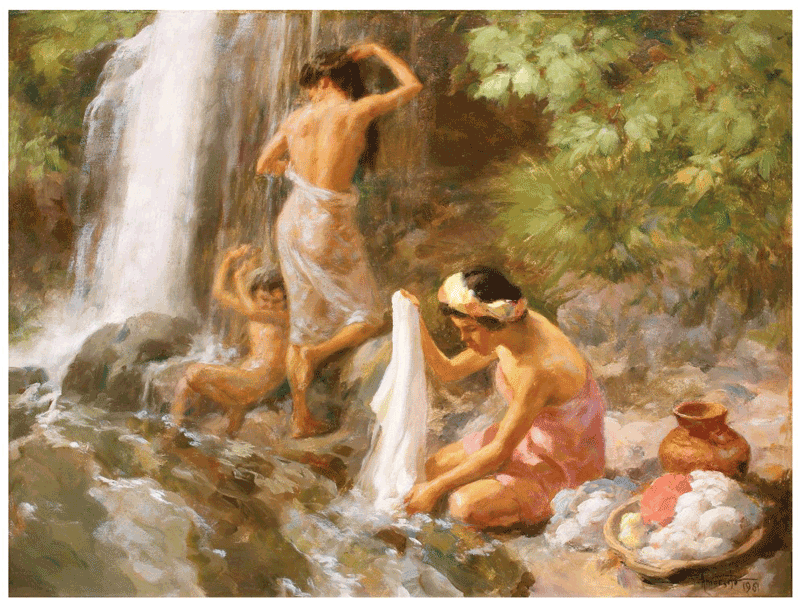MOST EXPENSIVE 'BALUT' EVER
Anita Magsaysay-Ho's 'Egg Vendors' sells for P62 million
Even in the usual León Gallery auction crammed with masters—which are always predicted to do well and hit their targets—there is still always room for the unexpected. Such was the case at its recent Magnificent September Auction of the year.
Top of the list was Anita Magsaysay-Ho’s “Egg Vendors,” whose appearance quickly started speculation among collectors about how much it would exactly clock in. There were learned discussions about its luminescence thanks to Anita’s mastery of the Renaissance medium, egg tempera, but also furrowed brows over its petite size at just 13 x 16.5 inches that could easily slip into an accountant’s ledger.
“I can reveal now that my own fearless forecast for this piece was P25 million,” said León Gallery director Jaime Ponce de Leon. In fact, the starting bid was at P7 million and the action took several minutes to warm up. The numbers, however, began to fly back and forth soon enough in rapid succession, finally hitting P53 million at hammer, or P62 million including buyer’s premium. Ponce de Leon noted that this was “because the Anita was quite simply divine—and the translucence achieved by the egg tempera is especially remarkable in this work.”

“When you talk about acreage,” he remarked, “this Anita actually outdid her ‘Tinapa Vendors’ as the record holder for the highest amount paid per per square inch for all of Philippine art. It brought in P288,600 per square inch versus ‘Tinapa Vendors,’ a much larger work, which rang in P262,800 per square inch at the eye-watering height of P84 million.”
This makes the Anita more valuable per square inch than a BGC penthouse—as art should be.
Chismis and Lavanderas
The other auction star serendipitously also featured another group of market vendors, this time by Vicente Manansala, in a piquantly titled work called “Chismis (Gossip).” The piece depicting the master as a curious fish ogling the owner came in at P26 million, with buyer’s premium.

The Siguion-Reyna Amorsolo, titled “Lavanderas,” also notched another world record. It was not far behind at P21 million and set a benchmark for 1960s’ Amorsolos. Ponce de Leon put this down to “its unique composition that sparked a bidding war.” (All of the Fernando Amorsolos, incidentally, performed very well at the recent sale.)

An Oscar Zalameda, dating from the same period as Magsaysay-Ho’s record-smashing “Egg Vendors,” offers the tantalizing theory of what would have happened if Zalameda had stayed on this expressionist course. Could he have become another National Artist like Joya or H.R. Ocampo instead of the beloved darling of the Forbes Park ladies who lunch? His mid-century marvel reeled in P7.6 million, setting another world record on its own for this artist. (It edged out León Gallery’s own record for a 5 x 12-foot work, which sold in November 2014 for P3.7 million.)
Annie Cabigting’s riff on Modigliani, titled “A Paris avec Une Amie Polanaise et Un Italien,” led the league of extraordinary contemporary artists and reaped a hefty P15.2 million. It likewise bested León Gallery’s own world record for this artist, previously set for the installation-sized work “Tearing into Pieces,” which had gone for “only” P10 million.

Arturo Luz’s triptych featuring a cyclist, juggler and musician also established another milestone for a post-2000 work by Luz at P8.2 million.
Other world records were established for artworks by Louie Cordero’s “Perpetual Deluge, Perpetual Guidance,” as well as National Artist Abdulmari Imao’s “Sarimanok” at P2.1 million and P1.5 million, respectively.
Don Jose Ma. Basa’s desk that featured a dozen fiery dragons took home P2 million, representing the value of its historicity as much as its fine detailing.
An exquisite “Olympic” Batangas “Mesa Altar” also vaulted to new heights for this kind of rare furniture at almost P5 million.

Works by John Santos, Lao Lianben, as well as Fernando Zobel, Cesar Legaspi and Hernando R. Ocampo had strong showings.
Summing up the results, Jaime Ponce de Leon said, “The auction showed a very bright overview of the market. There was absolute discernment on quality. The Anita may have been very small, but the collectors knew exactly what they were going after. The Annie Cabigting, likewise, was probably the smallest of that sort of subject matter, but it shattered the previous record for another work, which was monumental in size. Size, it must be gleaned, should not matter—nor should it be the basis of price. I hope this resonates with all art lovers out there.”

